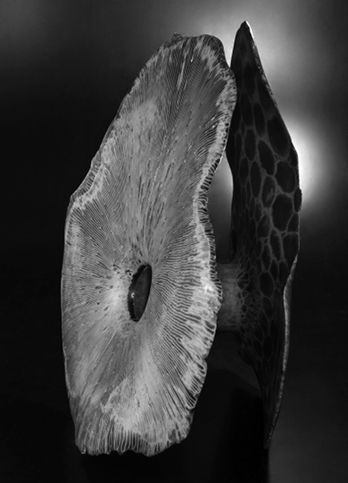Discussion
講評会
Comments on Top Prize Winners
(1/4)

Shape of Emotion
姜 旻杏 KANG, Min Haeng
(JAPAN)

光華 A Flowery Shine
塚田 美登里 TSUKADA, Midori
(JAPAN)
Takeda ───── We would like to begin with the Grand Prize
winner by Kang Min Haeng. Professor Carlson will make
some comments.
Carlson ───── First, I would like to say what a privilege and an honor it is to be returning to Kanazawa for the Exhibition Final Assessment. As a returning juror, I have the opportunity to compare what I saw in 2010 and have my eyes opened again in the works and the way that students, professionals, their identity of this mysterious material.
As Professor Takeda had mentioned, the jury did not battle on the decisions, but we had great discussions about which work we thought really elevated the creativity part of glass art.
In the end, our vote was taken and it was very close. There was a considerable discussion because these pieces really had the same support. But in the end, “Shape of Emotion” was the piece that we felt really gave us new information.
The casting quality and the way that the piece represents the interpret nature gave us an ability to see beyond the familiar As the juror, it is quite wonderful to have pieces that we feel all deserve top prize, but that can be. So we have to make a decision and that is wonderful obligation which goes along with decision making and trying to decide the pieces as they are recognized and appreciated.
So now my fellow juror, Laursen will tell us about her interpretation with this piece, Grand Prize winner.
Takeda ───── I would like Professor Laursen to make comment
on the Grand Prize as well.
Laursen ───── Good morning, everybody. Also I want very much to express my gratitude to be invited as a juror of this very interesting and important event, the International Exhibition of Glass Kanazawa 2013.
I have been doing works to see a great number of Japanese works of glass art throughout the years. I really have been aware of how high the standard of Japanese glass is nowadays.I must say I have not been disappointed.
The Grand Prize winner is vibrant and still solid. The soul and form of the sculpture are organic. When I saw it for the first time, I mentally heard the sound of the waves in my ears and I saw the tales of the waves rising high above the sea.
Yet the form of the sculpture and the lilac shapes are impressive.The color, at the same time, indicates the decay of which all organic material has to come to.
The title of the Grand Prize winner is “Shape of Emotion”.I hope the description of my own feelings and inner images at the first glance of the wonderful work you see here tells you that the artist has succeeded in creating and shaping emotions through this astonishing and brave work.
The work seems to bring together past and present and I am sure it even shows the way to the future for this interesting work and its maker.
Takeda ───── Next, I would like Professor Yokoyama to comment on the Gold Prize winner by Tsukada which was highly evaluated by all the jurors. It was quite difficult to decide which would be awarded the Grand Prize.
Yokoyama ───── The Gold Prize winner by Tsukada Midori, “A Flowery Shine,” is an excellent work with the combination of magnificent form and beauty of delicate patterns. Her design is so successful. The work also expresses something traditional as well as sculpturesque. It looks like a vase, a torso, and armor. At first glance I already decided to give an award to this work.
Takeda ───── I would also like to comment on some prize winners.I thought that there was nothing to choose between the two, the Grand and Gold prize winners. I felt this symbolizes two major directions of the postwar studio glass movement.
Tsukada brought this traditional glass vessel to completion as this dynamic object. It includes her concept such as dialogue with nature and her inimitable ingenuity in decorative elements. She has developed her skills and techniques to express herself. Kang Mim Haeng created her original form with her own concept. I felt her mental and spiritual durability and flexibility. I wondered if we had such form, shape,and color before.
Those two works are quite different from one another,though they each have unique expression and powerful originality in common. All the jurors highly evaluated the two works from the beginning of the assessment.

